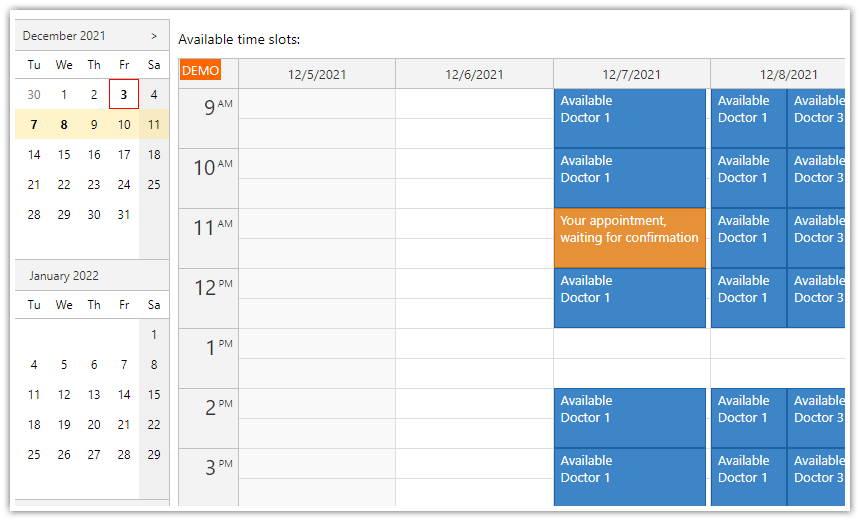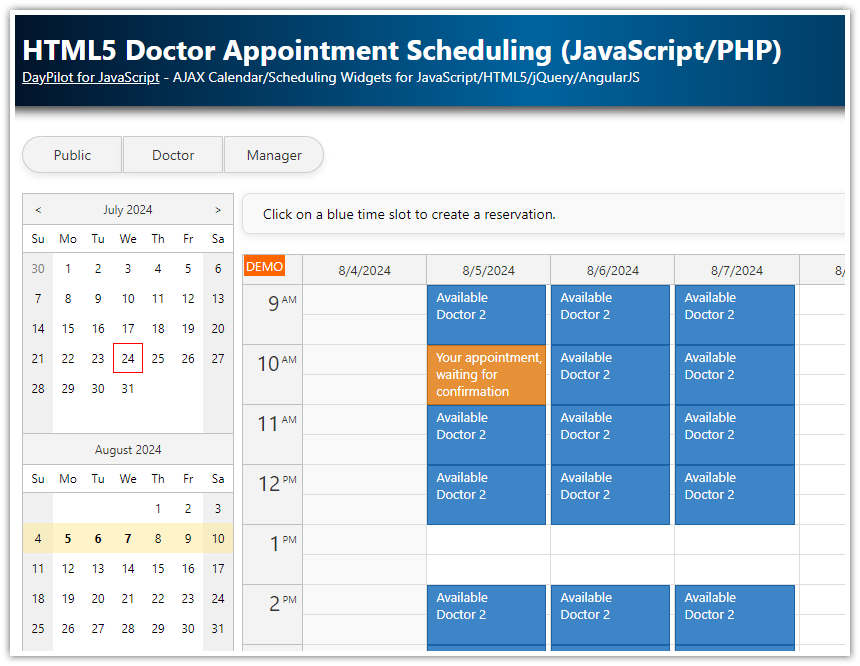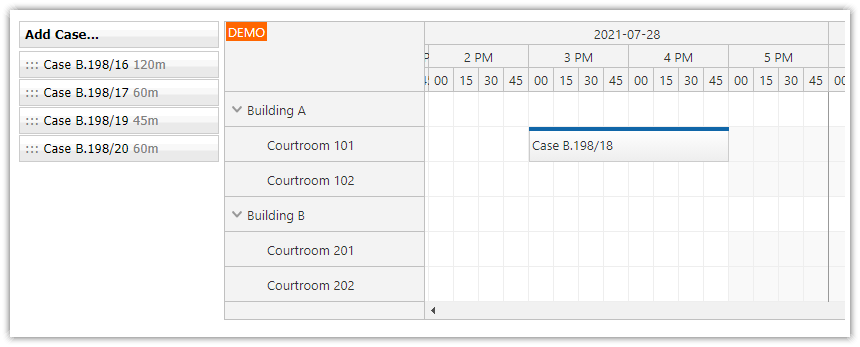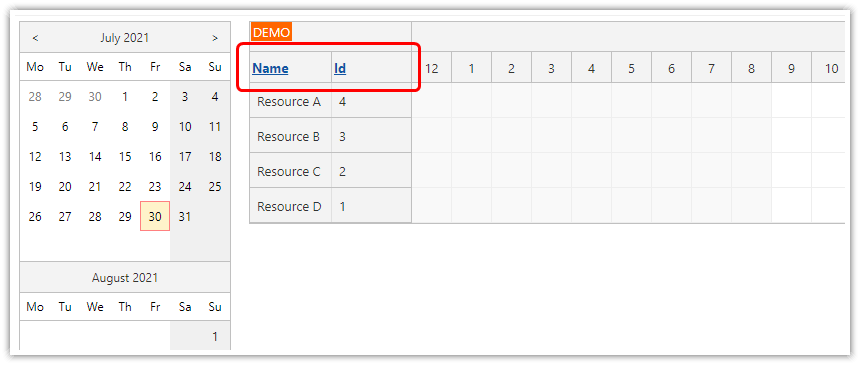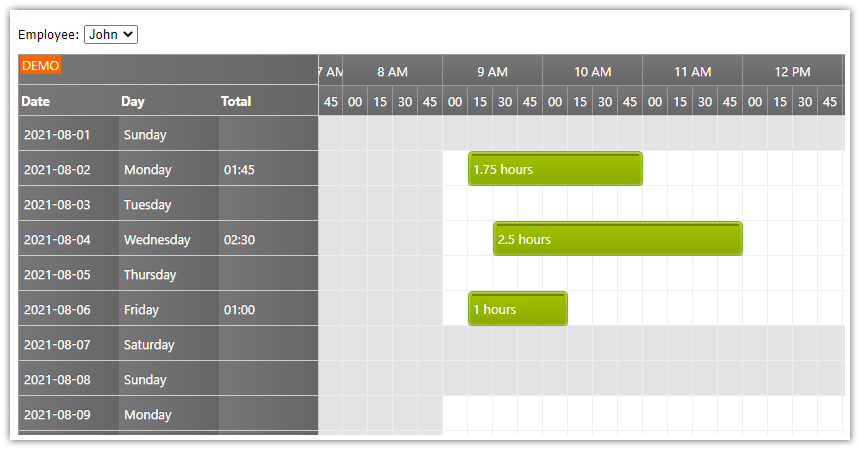Features
Public interface for patients
Doctor's interface for managing appointments
Manager's interface for scheduling shifts
Using pre-defined appointment slots
Appointment status: "free", "waiting", "confirmed"
SQL Server database (LocalDB)
Visual Studio 2017+
C# source code
VB.NET source code
Includes the trial version of DayPilot Pro for ASP.NET WebForms
License
Licensed for testing and evaluation purposes. You can use the source code of the tutorial if you are a licensed user of DayPilot Pro for ASP.NET WebForms.
See Also
This tutorial is also available for PHP:
And for ASP.NET Core (.NET 6):
1. Public Interface for Patients (Requesting an Appointment)

The public interface (Default.aspx) uses the ASP.NET event calendar control to display available appointment slots.
All appointment slots are created in the backend in advance.
The scheduled appointments are not visible in the public interface.
The user (patient) can click a free slot to request an appointment.
Requesting an Appointment

The user can click on a selected appointment slot and display a "Request an Appointment" modal dialog.
<div>
<p>Available time slots:</p>
<DayPilot:DayPilotCalendar
runat="server"
ID="DayPilotCalendar1"
...
EventClickHandling="JavaScript"
EventClickJavaScript="edit(e)"
/>
</div>
<script>
function edit(e) {
new DayPilot.Modal({
onClosed: function(args) {
if (args.result == "OK") {
dp.commandCallBack('refresh');
}
}
}).showUrl("Request.aspx?id=" + e.id());
}
function edit(e) {
var form = [
{ name: "Start", id: "start", dateFormat: "MMMM d, yyyy hh:mm tt", disabled: true },
{ name: "End", id: "end", dateFormat: "MMMM d, yyyy hh:mm tt", disabled: true },
{ name: "Your name", id: "name" },
];
var data = {
id: e.id(),
start: e.start(),
end: e.end()
};
DayPilot.Modal.form(form, data).then(function(modal) {
if (modal.canceled) {
return;
}
DayPilot.Http.ajax({
url: "Default.aspx/SaveRequest",
data: modal.result,
success: function(ajax) {
dp.commandCallBack('refresh');
dp.message("Saved");
}
});
});
}
</script>

After entering the name the appointment status will be changed to "waiting" and it will be displayed with an orange bar.
The modal dialog saves the changes using a call to a SaveRequest() WebMethod. This tutorial doesn’t use user authentication for simplicity. Instead, the current session is is used to detect the appointment owner.
C#
[WebMethod(EnableSession = true), ScriptMethod(ResponseFormat = ResponseFormat.Json)]
public static string SaveRequest(int id, string name)
{
// int id = Convert.ToInt32(idStr);
Db.RequestAppointment(id, name, HttpContext.Current.Session.SessionID);
Hashtable result = new Hashtable();
result["status"] = "OK";
return JsonConvert.SerializeObject(result);
}VB
<WebMethod(EnableSession:=True), ScriptMethod(ResponseFormat:=ResponseFormat.Json)>
Public Shared Function SaveRequest(ByVal id As Integer, ByVal name As String) As String
Db.RequestAppointment(id, name, HttpContext.Current.Session.SessionID)
Dim result As Hashtable = New Hashtable()
result("status") = "OK"
Return JsonConvert.SerializeObject(result)
End FunctionThe public interface displays all free slots and also all slots belonging to the current user. In this sample project, the user is recognized using the session ID (Session.SessionID) - normally this would be the ID from a user database.
C#
public static DataTable LoadFreeAndMyAppointments(DateTime start, DateTime end, string sessionId)
{
SqlDataAdapter da = new SqlDataAdapter("SELECT * FROM [Appointment] WHERE ([AppointmentStatus] = 'free' OR ([AppointmentStatus] <> 'free' AND [AppointmentPatientSession] = @session)) AND NOT (([AppointmentEnd] <= @start) OR ([AppointmentStart] >= @end))", ConfigurationManager.ConnectionStrings["daypilot"].ConnectionString);
da.SelectCommand.Parameters.AddWithValue("session", sessionId);
da.SelectCommand.Parameters.AddWithValue("start", start);
da.SelectCommand.Parameters.AddWithValue("end", end);
DataTable dt = new DataTable();
da.Fill(dt);
return dt;
}VB
Public Shared Function LoadFreeAndMyAppointments(ByVal start As Date, ByVal [end] As Date, ByVal sessionId As String) As DataTable
Dim da As New SqlDataAdapter("SELECT * FROM [Appointment] WHERE ([AppointmentStatus] = 'free' OR ([AppointmentStatus] <> 'free' AND [AppointmentPatientSession] = @session)) AND NOT (([AppointmentEnd] <= @start) OR ([AppointmentStart] >= @end))", ConfigurationManager.ConnectionStrings("daypilot").ConnectionString)
da.SelectCommand.Parameters.AddWithValue("session", sessionId)
da.SelectCommand.Parameters.AddWithValue("start", start)
da.SelectCommand.Parameters.AddWithValue("end", [end])
Dim dt As New DataTable()
da.Fill(dt)
Return dt
End Function2. Manager's Interface (Scheduling Shifts)
The management interface (Manager.aspx) allows creating appointment slots. This view displays a timeline for all doctors and allows scheduling shifts.
Shifts View

This view uses the ASP.NET scheduler control to display appointments for all doctors.
Doctors are defined as resources:
C#
private void LoadDoctors()
{
DataTable doctors = Db.LoadDoctors();
DayPilotScheduler1.Resources.Clear();
foreach (DataRow row in doctors.Rows)
{
DayPilotScheduler1.Resources.Add((string)row["DoctorName"], Convert.ToString(row["DoctorId"]));
}
}VB
Private Sub LoadDoctors()
Dim doctors As DataTable = Db.LoadDoctors()
DayPilotScheduler1.Resources.Clear()
For Each row As DataRow In doctors.Rows
DayPilotScheduler1.Resources.Add(DirectCast(row("DoctorName"), String), Convert.ToString(row("DoctorId")))
Next row
End Sub
The time header displays a custom timeline. The timeline only includes the pre-defined shifts (morning shift from 9am to 13pm, afternoon shift from 2pm to 6pm).
C#
private const int MorningShiftStarts = 9;
private const int MorningShiftEnds = 13;
private const int AfternoonShiftStarts = 14;
private const int AfternoonShiftEnds = 18;
private void LoadTimelineShifts()
{
DayPilotScheduler1.Scale = TimeScale.Manual;
DayPilotScheduler1.Timeline.Clear();
for (int i = 0; i < DayPilotScheduler1.Days; i++)
{
DateTime day = DayPilotScheduler1.StartDate.AddDays(i);
DayPilotScheduler1.Timeline.Add(day.AddHours(MorningShiftStarts), day.AddHours(MorningShiftEnds));
DayPilotScheduler1.Timeline.Add(day.AddHours(AfternoonShiftStarts), day.AddHours(AfternoonShiftEnds));
}
DayPilotScheduler1.TimeHeaders.Clear();
DayPilotScheduler1.TimeHeaders.Add(new TimeHeader(GroupByEnum.Month));
DayPilotScheduler1.TimeHeaders.Add(new TimeHeader(GroupByEnum.Day, "ddd d"));
DayPilotScheduler1.TimeHeaders.Add(new TimeHeader(GroupByEnum.Cell, "tt"));
}VB
Private Const MorningShiftStarts As Integer = 9
Private Const MorningShiftEnds As Integer = 13
Private Const AfternoonShiftStarts As Integer = 14
Private Const AfternoonShiftEnds As Integer = 18
Private Sub LoadTimelineShifts()
DayPilotScheduler1.Scale = TimeScale.Manual
DayPilotScheduler1.Timeline.Clear()
For i As Integer = 0 To DayPilotScheduler1.Days - 1
Dim day As Date = DayPilotScheduler1.StartDate.AddDays(i)
DayPilotScheduler1.Timeline.Add(day.AddHours(MorningShiftStarts), day.AddHours(MorningShiftEnds))
DayPilotScheduler1.Timeline.Add(day.AddHours(AfternoonShiftStarts), day.AddHours(AfternoonShiftEnds))
Next i
DayPilotScheduler1.TimeHeaders.Clear()
DayPilotScheduler1.TimeHeaders.Add(New TimeHeader(GroupByEnum.Month))
DayPilotScheduler1.TimeHeaders.Add(New TimeHeader(GroupByEnum.Day, "ddd d"))
DayPilotScheduler1.TimeHeaders.Add(New TimeHeader(GroupByEnum.Cell, "tt"))
End Sub
Hours View

It is possible to switch to a more detailed "hours" scale.
The current cell size (shifts/hours) is stored in the ClientState property (
size).A refresh of the Scheduler is requested using commandCallBack() client-side method.
Manager.aspx
<div class="space">Scale: <a href="javascript:scale('shifts')">Shifts</a> | <a href="javascript:scale('hours')">Hours</a></div>
<script type="text/javascript">
function scale(size) {
dp.clientState.size = size;
dp.commandCallBack("refresh");
}
</script>C#
protected void DayPilotScheduler1_OnCommand(object sender, CommandEventArgs e)
{
switch (e.Command)
{
case "refresh":
LoadTimeline();
LoadDoctors();
LoadAppointments();
break;
// ...
}
}
private void LoadTimeline()
{
string scaleSize = (string)DayPilotScheduler1.ClientState["size"];
switch (scaleSize)
{
case "hours":
LoadTimelineHours();
break;
case "shifts":
LoadTimelineShifts();
break;
}
}
private void LoadTimelineHours()
{
DayPilotScheduler1.Scale = TimeScale.Manual;
DayPilotScheduler1.Timeline.Clear();
for (int i = 0; i < DayPilotScheduler1.Days; i++)
{
DateTime day = DayPilotScheduler1.StartDate.AddDays(i);
for (int x = MorningShiftStarts; x < MorningShiftEnds; x++)
{
DayPilotScheduler1.Timeline.Add(day.AddHours(x), day.AddHours(x + 1));
}
for (int x = AfternoonShiftStarts; x < AfternoonShiftEnds; x++)
{
DayPilotScheduler1.Timeline.Add(day.AddHours(x), day.AddHours(x + 1));
}
}
DayPilotScheduler1.TimeHeaders.Clear();
DayPilotScheduler1.TimeHeaders.Add(new TimeHeader(GroupByEnum.Month));
DayPilotScheduler1.TimeHeaders.Add(new TimeHeader(GroupByEnum.Day, "ddd d"));
DayPilotScheduler1.TimeHeaders.Add(new TimeHeader(GroupByEnum.Hour, "ht"));
}VB
Protected Sub DayPilotScheduler1_OnCommand(ByVal sender As Object, ByVal e As CommandEventArgs)
Select Case e.Command
Case "refresh"
LoadTimeline()
LoadDoctors()
LoadAppointments()
' ...
End Select
End Sub
Private Sub LoadTimeline()
Dim scaleSize As String = CStr(DayPilotScheduler1.ClientState("size"))
Select Case scaleSize
Case "hours"
LoadTimelineHours()
Case "shifts"
LoadTimelineShifts()
End Select
End Sub
Private Sub LoadTimelineHours()
DayPilotScheduler1.Scale = TimeScale.Manual
DayPilotScheduler1.Timeline.Clear()
For i As Integer = 0 To DayPilotScheduler1.Days - 1
Dim day As Date = DayPilotScheduler1.StartDate.AddDays(i)
For x As Integer = MorningShiftStarts To MorningShiftEnds - 1
DayPilotScheduler1.Timeline.Add(day.AddHours(x), day.AddHours(x + 1))
Next x
For x As Integer = AfternoonShiftStarts To AfternoonShiftEnds - 1
DayPilotScheduler1.Timeline.Add(day.AddHours(x), day.AddHours(x + 1))
Next x
Next i
DayPilotScheduler1.TimeHeaders.Clear()
DayPilotScheduler1.TimeHeaders.Add(New TimeHeader(GroupByEnum.Month))
DayPilotScheduler1.TimeHeaders.Add(New TimeHeader(GroupByEnum.Day, "ddd d"))
DayPilotScheduler1.TimeHeaders.Add(New TimeHeader(GroupByEnum.Hour, "ht"))
End SubAppointment Status (Free, Waiting, Confirmed)
The scheduler displays appointments with a color bar depending on the appointment status.

New appointment slots have a "free" status. They are displayed with a green bar.

Slots booked by patients using the public interface have a "waiting" status and are displayed with an orange bar.

As soon as the appointment request is confirmed by the doctor the status changes to "confirmed" and the appointment is displayed with a red bar.
The status is stored in AppointmentStatus database field. This field is loaded as a special "tag" using DataTagFields property:
C#
private void LoadAppointments()
{
DataTable table = Db.LoadAppointments(DayPilotScheduler1.VisibleStart, DayPilotScheduler1.VisibleEnd);
DayPilotScheduler1.DataSource = table;
DayPilotScheduler1.DataIdField = "AppointmentId";
DayPilotScheduler1.DataTextField = "AppointmentPatientName";
DayPilotScheduler1.DataStartField = "AppointmentStart";
DayPilotScheduler1.DataEndField = "AppointmentEnd";
DayPilotScheduler1.DataTagFields = "AppointmentStatus";
DayPilotScheduler1.DataResourceField = "DoctorId";
DayPilotScheduler1.DataBind();
DayPilotScheduler1.Update();
}
VB
Private Sub LoadAppointments()
Dim table As DataTable = Db.LoadAppointments(DayPilotScheduler1.VisibleStart, DayPilotScheduler1.VisibleEnd)
DayPilotScheduler1.DataSource = table
DayPilotScheduler1.DataIdField = "AppointmentId"
DayPilotScheduler1.DataTextField = "AppointmentPatientName"
DayPilotScheduler1.DataStartField = "AppointmentStart"
DayPilotScheduler1.DataEndField = "AppointmentEnd"
DayPilotScheduler1.DataTagFields = "AppointmentStatus"
DayPilotScheduler1.DataResourceField = "DoctorId"
DayPilotScheduler1.DataBind()
DayPilotScheduler1.Update()
End SubThis tag is later available in BeforeEventRender event handler and we can use it to set a custom bar color:
C#
protected void DayPilotScheduler1_OnBeforeEventRender(object sender, BeforeEventRenderEventArgs e)
{
string status = e.Tag["AppointmentStatus"];
switch (status)
{
case "free":
e.DurationBarColor = "#6aa84f"; // green
e.EventDeleteEnabled = ScaleResolved == "hours"; // only allow deleting in the more detailed hour scale mode
break;
case "waiting":
e.DurationBarColor = "#e69138"; // orange
e.EventDeleteEnabled = false;
break;
case "confirmed":
e.DurationBarColor = "#cc0000"; // red
e.EventDeleteEnabled = false;
break;
}
}VB
Protected Sub DayPilotScheduler1_OnBeforeEventRender(ByVal sender As Object, ByVal e As BeforeEventRenderEventArgs)
Dim status As String = e.Tag("AppointmentStatus")
Select Case status
Case "free"
e.DurationBarColor = "#6aa84f" ' green
e.EventDeleteEnabled = ScaleResolved = "hours" ' only allow deleting in the more detailed hour scale mode
Case "waiting"
e.DurationBarColor = "#e69138" ' orange
e.EventDeleteEnabled = False
Case "confirmed"
e.DurationBarColor = "#cc0000" ' red
e.EventDeleteEnabled = False
End Select
End Sub3. Doctor's Interface (Scheduling Appointments)

The doctor's view (Doctor.aspx) displays a full week (all 24 hours each day) for the selected doctor.
It allows editing the appointment slots:
Changing the slot status
Moving a resizing appointment slots using drag and drop
Deleting appointment slots

The Edit.aspx page displays appointment details in a modal dialog.
4. SQL Server Database Schema

[Doctor] Table
CREATE TABLE [dbo].[Doctor] (
[DoctorId] INT IDENTITY (1, 1) NOT NULL,
[DoctorName] NVARCHAR (100) NOT NULL,
PRIMARY KEY CLUSTERED ([DoctorId] ASC)
);
[Appointment] Table
CREATE TABLE [dbo].[Appointment] (
[AppointmentId] INT IDENTITY (1, 1) NOT NULL,
[AppointmentStart] DATETIME NOT NULL,
[AppointmentEnd] DATETIME NOT NULL,
[DoctorId] INT NOT NULL,
[AppointmentPatientName] NVARCHAR (100) NULL,
[AppointmentStatus] NVARCHAR (100) DEFAULT ('free') NOT NULL,
[AppointmentPatientSession] NVARCHAR (100) NULL,
PRIMARY KEY CLUSTERED ([AppointmentId] ASC)
);ASP.NET Core Scheduler
To learn how to use the Scheduler component in ASP.NET Core, please see the ASP.NET Core Scheduler tutorial.
History
December 21, 2020: DayPilot Pro for ASP.NET WebForms 2020.4.3775; using DayPilot.Modal.form() for dialogs
Sep 21, 2017: Visual Studio 2017, SQL Server 2014+, DayPilot Pro for ASP.NET WebForms 8.4
Jun 30, 2015: Initial release
 DayPilot
DayPilot
